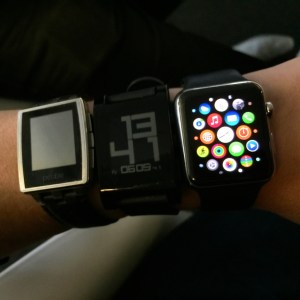Companies that neglect to bring the Internet of Things, wearables and mobile into their marketing mix are going to find themselves in the same boat as businesses that last decade resisted creating websites—sinking fast. For now, let’s forget the science fiction-like future where we will be eventually able to have brands implanted in more than our memory, and focus on how marketing can and will be reshaped by wearables. In fact, we could venture to bet that wearables have changed marketing more than probably anything else in 2016 – and we’ve got the lowdown of just how.
“When it comes to market research, wearables are closing the gap between the reported or remembered and actual behaviour significantly,” Maya Middlemiss, managing director of U.K.-based Saros market research company, told Blog ThinkBig. We’re no longer going to need to solicit information from our target audiences, a la Mad Men, you’re just going to provide us with it, enabling us to respond with tailored marketing.
In fitness it’s already happening. While others like Nike have failed or like Apple have fumbled, no company has proven that wearables are here to stay more than the one most likely to be on your wrist—unicorn four times over, Fitbit. Of course fitness is the most logical wearable success story because it appeals to our desire for instant gratification for something that actually takes a lot of work. Because of that, it’s a logical segue for the mobile apps or the device itself to deliver you ads not only to assist in those quick results—juicing recipes books, vitamins or diet pills—but, after understanding what kind of exercise you do, suggesting the right workout gear, or, vice versa, send you a deal for a local gym when you get lazier.

But the next generation of wearable-based advertising is not just about what you’re doing but where you’re doing it. As we’ve already touched on, location-based marketing becomes increasingly about context-aware marketing. While disguising your identity, it combines the general information you’ve already provided on your smartphone—age, sex, location—and your habits concluded by your wearables and other devices. From here, marketing analytics can decipher your needs, wants, and desires, especially from a shopping standpoint. In fact, they can build a rather specific profile on you. For example, imagine you spend a lot of time in your favourite department store, looking at maternity wear, that store can assume that you’re expecting and start sending you offers for baby stuff. Or perhaps, three times this month, you’ve spent more than five minutes each in the washer-dryer section, but, since a beacon hasn’t detected you at the checkout, they can know you haven’t made a purchase yet; on the payday first of the month, your Apple Watch pops up with a special offer of free delivery on any purchase this weekend.
Google and Facebook have made a living off of feeding us ads based on what we’ve searched for and what we’ve looked at, but they aren’t always accurate. I look at a lot of videos of puppies, but don’t have one, yet not a week goes by without me seeing a Purina ad. Wearables will help us generate big data than ever before, allowing for machine learning and extremely narrow, knowledgeable and reactive ad campaigns.
And—going so much farther than Google Glass—wearables don’t just give us insight into shopper behaviour, it helps us learn from shoppers’ subscious movements and responses too. It’s making for the most informed market research ever.
“For example in terms of shopper behaviour, we used to ask people about what they remembered seeing in a store or what fixtures caught their attention. Now we can fit them with a camera and literally see through their eyes, or aggregate data from many shoppers to create a heat-map of what draws visitors’ attention,” Middlemiss said. “This means the research can concentrate on the reasons behind this behaviour, instead of validating the behaviour in the first place”








